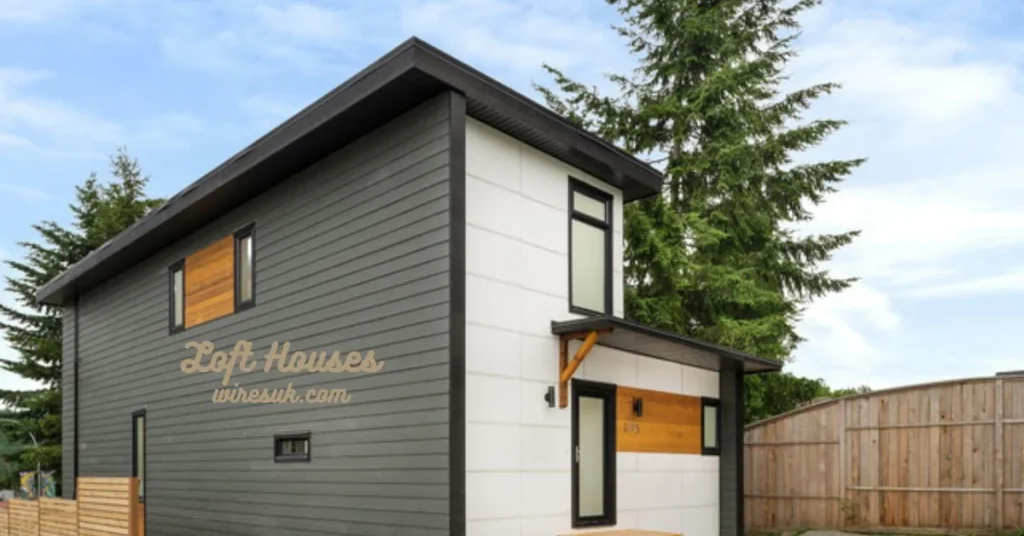Introduction
Loft houses have become a popular architectural and design trend in recent years, captivating the imagination of homeowners and designers alike. Known for their open spaces, high ceilings, and unique industrial charm, loft houses offer a distinctive living experience that combines both modern and historical elements. This comprehensive guide explores the essence of loft houses, their design features, benefits, and current trends, providing valuable insights for those considering a loft-style living space.
What is a Loft House?
A Loft Houses, often referred to simply as a loft, is a type of residential building characterized by its spacious, open-plan interior and high ceilings. The concept originated in the mid-20th century when industrial buildings, particularly in urban areas, were converted into residential spaces. These buildings typically had large, open floor plans with minimal interior walls, large windows, and exposed structural elements.
Historical Context
The transformation of industrial spaces into residential lofts began in New York City in the 1950s and 1960s. Artists and creative professionals, seeking affordable studio spaces, began to inhabit old warehouses and factories in neighborhoods like SoHo. The aesthetic of these converted spaces, with their exposed brick walls, steel beams, and large windows, quickly gained popularity and became a symbol of urban cool.
Key Features of Loft Houses

Loft houses are renowned for their distinctive architectural and design features, which set them apart from traditional homes. Here are some of the key elements that define a loft house:
Open Floor Plans
One of the most defining features of a loft house is its open floor plan. Unlike traditional homes with multiple rooms and segmented spaces, loft houses typically have a large, uninterrupted living area. This open layout allows for flexibility in how the space is used and facilitates a sense of spaciousness.
High Ceilings
Loft houses often feature high ceilings, sometimes reaching up to 20 feet or more. This vertical space enhances the feeling of openness and allows for the incorporation of dramatic architectural elements, such as exposed beams and skylights.
Industrial Elements
Exposed industrial elements are a hallmark of loft house design. These may include raw brick walls, concrete floors, steel beams, and ductwork. These elements, originally part of the building’s industrial function, contribute to the loft’s unique character and historical charm.
Large Windows
Large windows are another characteristic feature of loft houses. They provide ample natural light, making the space feel even more expansive. In many lofts, windows are original to the industrial building, often featuring steel frames and providing a view of the surrounding urban landscape.
Minimalist Design
Loft houses often embrace a minimalist design aesthetic. The open floor plan and industrial features serve as the primary decorative elements, while furniture and decor are typically kept to a minimum. This approach allows the architectural elements to shine and prevents the space from feeling cluttered.
Benefits of Living in a Loft House

Living in a loft house offers several advantages, making it an attractive option for many homeowners. Here are some of the key benefits:
Spaciousness
The open floor plan of a loft house creates a sense of spaciousness that can be hard to achieve in traditional homes. This openness allows for versatile use of space and can make even smaller lofts feel larger than they are.
Unique Aesthetic
The distinctive aesthetic of a loft house, with its combination of industrial and modern elements, appeals to those who appreciate a contemporary and stylish living environment. The character of exposed brick, steel beams, and large windows contributes to a unique and visually striking home.
Natural Light
The large windows typical of loft houses allow for abundant natural light, which can enhance mood and well-being. Natural light also helps to make the space feel more open and airy.
Flexibility
The open layout of a loft house provides flexibility in how the space is used and arranged. Homeowners can easily adapt the layout to suit their needs, whether they want to create separate living areas, a home office, or a creative studio.
Connection to Urban Environment
Loft houses are often located in urban areas, providing residents with easy access to city amenities, cultural attractions, and vibrant neighborhoods. Living in a loft can enhance one’s connection to the city and its dynamic lifestyle.
Designing a Loft House
Designing a loft house involves creating a harmonious blend of architectural features, decor, and functionality. Here are some tips and considerations for designing a loft house:
Embrace the Architecture
One of the key aspects of designing a loft house is to embrace its architectural features. Highlighting exposed brick, steel beams, and large windows can enhance the space’s character. Consider incorporating these elements into the design rather than covering them up.
Choose the Right Furniture
In a loft house, furniture should complement the open layout and industrial aesthetic. Opt for pieces that are sleek and modern, with clean lines and simple forms. Avoid bulky or ornate furniture that could overwhelm the space.
Use Area Rugs and Dividers
While loft houses have open floor plans, it can be helpful to define different areas within the space. Area rugs, furniture arrangements, and decorative screens or dividers can help create distinct zones for living, dining, and working.
Incorporate Lighting
Lighting is an important element in loft house design. Consider a mix of ambient, task, and accent lighting to create a well-lit and functional space. Pendant lights, floor lamps, and track lighting can complement the industrial aesthetic and provide flexibility.
Add Personal Touches
While the minimalist approach is often favored in loft design, adding personal touches can make the space feel more inviting. Incorporate artwork, plants, and decorative items that reflect your style and personality.
Current Trends in Loft House Design

Loft house design continues to evolve, with new trends emerging to meet the changing preferences of homeowners. Here are some of the current trends in loft house design:
Green and Sustainable Design
Sustainability is becoming increasingly important in residential design. Many loft houses now incorporate eco-friendly materials, energy-efficient appliances, and sustainable practices. Green roofs, reclaimed materials, and energy-efficient windows are some of the features that align with this trend.
Industrial Chic
The industrial chic trend combines the raw, industrial elements of loft houses with a touch of elegance and sophistication. This trend often includes the use of high-end materials, such as marble countertops and designer fixtures, alongside exposed brick and steel.
Multi-Functional Spaces
With the growing trend of remote work and flexible living arrangements, many loft houses are designed with multi-functional spaces. This may include home offices, guest rooms, or creative studios that can be easily adapted to different uses.
Smart Home Technology
The integration of smart home technology is becoming more common in loft houses. Smart thermostats, lighting systems, and security features can enhance convenience and control while maintaining the minimalist aesthetic.
Art and Culture
Incorporating art and cultural elements into loft house design is a popular trend. This can include displaying artwork, sculptures, or cultural artifacts that complement the industrial aesthetic and add a personal touch to the space.
Challenges of Living in a Loft House
While loft houses offer many benefits, they also come with their own set of challenges. Here are some of the common challenges faced by loft homeowners:
Privacy
The open floor plan of a loft house can pose challenges in terms of privacy. Without walls or separate rooms, it can be difficult to create private spaces or to isolate noise. Creative solutions, such as partition screens or curtains, can help address this issue.
Temperature Control
High ceilings and large windows can make temperature control more challenging in a loft house. Heating and cooling systems need to be carefully designed to ensure consistent comfort throughout the space.
Maintenance
The exposed industrial elements of a loft house, such as raw brick or concrete floors, can require regular maintenance to keep them looking their best. Dust and dirt can accumulate in these areas, necessitating frequent cleaning.
Noise
Loft houses are often located in urban areas, which can lead to exposure to external noise. Additionally, the open floor plan can result in increased noise levels within the home. Soundproofing measures and strategic furniture placement can help mitigate this issue.
Frequently Asked Questions (FAQs) About Loft Houses
1. What is a loft house?
A loft house is a type of residential space characterized by its open floor plan, high ceilings, and industrial design elements. Originally, lofts were created by converting old industrial buildings like warehouses or factories into living spaces. They are known for their spaciousness, large windows, and exposed structural features.
2. How does a loft house differ from a traditional home?
The main differences lie in the design and layout. Loft houses typically feature an open-plan layout without many internal walls, creating a large, uninterrupted space. Traditional homes often have more defined rooms and walls, offering more privacy but less flexibility. Loft houses also tend to have an industrial aesthetic, with elements like exposed brick, steel beams, and large windows.
3. Are loft houses suitable for families?
Loft houses can be suitable for families, but they require careful planning to accommodate the needs of multiple people. The open floor plan can make privacy a challenge, so it’s important to create defined areas using furniture, partitions, or curtains. Families with young children might find it more difficult to adapt to the open and potentially noisy environment.
4. What are the main advantages of living in a loft house?
The advantages of living in a loft house include a spacious and flexible living environment, a unique and modern aesthetic, ample natural light, and a strong connection to urban life. The open space allows for creative interior design, and the large windows provide excellent light and views.
5. What are the challenges of loft living?
Challenges include a lack of privacy due to the open layout, difficulties with temperature control (especially in spaces with high ceilings and large windows), potential noise issues, both from within the loft and from outside, and the need for regular maintenance of exposed industrial elements like brick walls and concrete floors.
Conclusion
Loft houses offer a unique and captivating living experience, blending industrial charm with modern design. Their spacious open floor plans, high ceilings, and distinctive architectural features make them a popular choice for those seeking a stylish and flexible living space. While there are challenges associated with loft living, the benefits and trends in loft house design continue to evolve, ensuring that these spaces remain a dynamic and appealing option for homeowners.
Whether you are considering a loft house for its aesthetic appeal, its connection to urban life, or its versatile design, understanding the key features and current trends can help you make the most of this distinctive living arrangement. As loft houses continue to inspire and innovate, they remain a symbol of contemporary design and urban sophistication.









